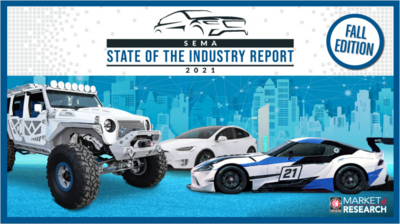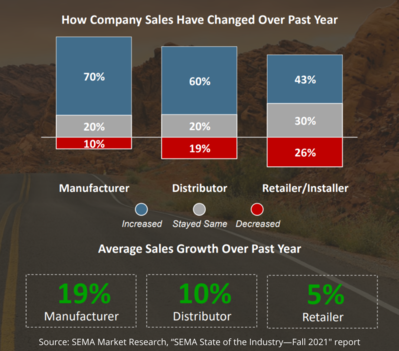By Ashley Reyes
 Despite ongoing disruptions in the economy, 70% of specialty-equipment manufacturers report sales growth over the past year, according to the new “State of the Industry—Fall 2021” report from SEMA.
Despite ongoing disruptions in the economy, 70% of specialty-equipment manufacturers report sales growth over the past year, according to the new “State of the Industry—Fall 2021” report from SEMA.
The report highlights specialty-equipment market trends, including sales performance and expectations, broader economic factors that are affecting the industry, and a future outlook on the role that emerging vehicle technologies may play.
Supply-chain disruptions are affecting the automotive sector, and new-vehicle production is expected to be 7.7 million units lower in 2021 than 2020—tempering the specialty-equipment industry’s optimism regarding its short-term prospects. However, most businesses are maintaining a positive outlook, with more than 80% expecting their sales to be stable or growing over the coming year.
 The latest edition of SEMA’s ongoing “State of the Industry” report series offers 70 pages of data on the specialty-equipment industry to help companies understand how the market is performing and evolving. Key findings from the report include:
The latest edition of SEMA’s ongoing “State of the Industry” report series offers 70 pages of data on the specialty-equipment industry to help companies understand how the market is performing and evolving. Key findings from the report include:
- Delays in shipping and the ongoing microchip shortage have left automakers unable to keep up with consumer demand for new vehicles, pushing dealer inventories to all-time lows and the average price of a new vehicle to an unprecedented $45,000 in September 2021.
- While some businesses struggled during the beginning of the pandemic last year, especially retailers, most were able to adjust. Manufacturers in particular have done well, reporting an average of 19% sales growth over the past 12 months.
- Sales in the pickup, sports car, SUV and classic vehicle segments continue to be strong, with many businesses once again seeing double-digit sales growth this year.
- Supply-chain disruptions are starting to create some uncertainty. In the spring of 2021, 70% of specialty-equipment manufacturers and 75% of distributors expected their sales to grow over the coming year. However, those percentages have fallen to 58% and 52% respectively.
- The temporary shifts towards online sales that were made necessary by the pandemic are continuing to reverse, with the majority of specialty-equipment parts sales once again flowing through in-person retail channels.
- In the longer term, vehicle manufacturers’ plans to develop and sell more electric vehicles will require the specialty-equipment industry to plan for and adapt to these changes in the vehicle population.
For more data on the state of U.S. specialty-equipment market, download the “SEMA State of the Industry—Fall 2021” report for free today at www.sema.org/research.





